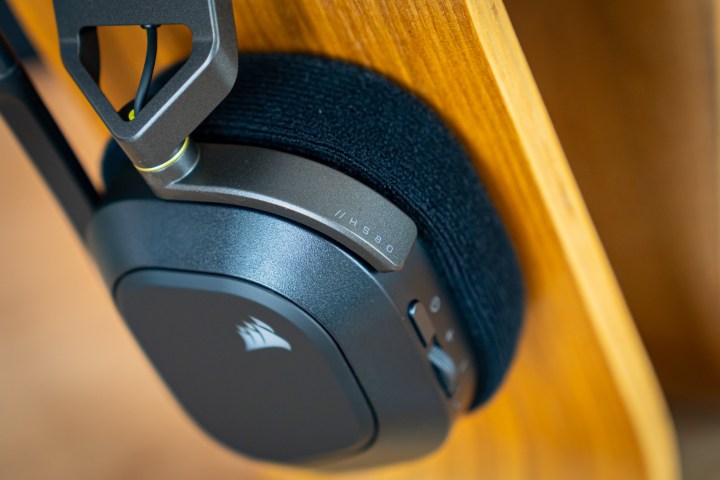“Corsair's HS80 hits the nail on the head with a less is more approach, offering superb comfort, great sound, and effortless controls.”
- Intuitive controls
- Great sound quality
- Oh-so comfortable
- Wireless connectivity with PC and Playstation
- RGB
- No removable mic
With as much choice on the market as there is, buying a new gaming headset isn’t easy. If you’re suffering from decision paralysis, it’s easy to opt for something top-end, like Corsair’s Virtuoso RGB Wireless XT, which not only looks great, but also comes jam-packed with features. The problem? It carries a hefty price tag and still isn’t perfect. That’s where something like Corsair’s new HS80 RGB Wireless comes in.
At first, the HS80 didn’t have me very excited. It’s not premium, just mid-tier, so it isn’t full of features and doesn’t boast the most luxurious materials. But, in a way, that’s its best quality, making it possibly one of my favorite new gaming headsets.
Design and features

For the HS80, Corsair didn’t focus on making the prettiest headset. Rather, the focus here is on comfort. It uses a headband-style fit at the top that flexes to perfectly match your skull, making it one of the more comfortable headsets I’ve tested. The earcups feature fabric on the foam, which, again, isn’t the most luxurious material.
But it does offer plenty of depth for wider ears, and the headset has an asymmetrical design to accommodate your earlobe. As such, the HS80 doesn’t feel like an expensive headset, but it is supple and smooth in its fitment. This is a headset that you could wear for hours on end, and that headband makes it more comfortable than a headset with a classic design such as the Razer Blackshark V2 Pro.
Then there are the HS80’s controls, or rather, lack thereof. On the left earcup, you’ll find a power button and volume roller, and that’s it. The right earcup is completely devoid of controls. What’s clearly missing is a mic-mute button, but it’s there all right: Just flip the microphone up to mute it and down to unmute. It also has a chime to let you know what it’s doing, and the light at the end goes red in the up position, though this isn’t as helpful on a mic like this because it’s out of sight. This means less buttons than most headsets, and the action of simply flipping the mic up is much more intuitive than fumbling to find the mute button, like you have to on the SteelSeries Arctis 7 or Logitech G Pro X Wireless headsets.
The simplicity of the HS80’s controls make it one of the most intuitive gaming headsets to use.
Charging happens via a standard USB-C port, with battery life rated at up to 20 hours, which is about industry standard – expect to charge the HS80 once or twice a week. Connectivity happens via a USB dongle that plugs into PCs and laptops, along with PlayStation 4 and PS5 units.

But this simplicity is just what’s great about the HS80 – many headsets with tons of features have too many controls, and fumbling around to find the right ones can be tedious. This is one you just turn on, change the volume, and flip the mic up and down to mute – it’s as simple as that.
Sound quality and gaming
Normally, wireless gaming headsets don’t have the best sound quality due to limitations in the wireless protocol – the dongle has the audio stream prioritized for latency and not quality, which leads to some compression losses along the way. The HS80 is no exception, but all things considered, its sound profile is actually highly pleasing.

Let me explain: When listening to calm music, you won’t notice a thing that’s wrong. In fact, you’ll quite enjoy the sound from the HS80 thanks to its excellent 50mm drivers. Butut when music gets busy, you’ll start to hear some compression losses. But it’s a headset for gaming, and in-game, you’re generally too busy to pay attention to these losses – and if you’re not – it’s probably a chilled scene playing calmer sounds that don’t suffer from these losses anyway.
Pleather earcups might look better, but the HS80’s foam earcups elevate its sound profile.
The HS80 comes with the same 50mm drivers as those found on the much more expensive Virtuoso XT Wireless RGB, so they sound just as good in terms of frequency response and sound signature. Actually, scratch that, they sound better – I actually prefer the sound produced by the HS80 over the more expensive headset.
I’m guessing this has to do with the foam cushions instead of pleather, along with the shape of the earcups – the softer materials lead to a warmer and fuller sound without sacrificing detail at the top end.
The HS80 also come with Dolby Atmos support that you can enable via Corsair’s iCue software. While it does paint a slightly better 3D image of the sound around you, I’m generally not a huge fan of these sound-modifying algorithms – yes, they broaden the soundstage and make sounds seem like they’re further away with more “position,” but the reduction in intimacy leaves a flatter sound that, subjectively, is less detailed. I just leave it off – sound engines in today’s games are plenty good anyway, especially a game like Insurgency Sandstorm.
Our take
Having had a solid week with the Corsair HS80, I can say with confidence that it is one of the best gaming headsets currently available. It might not be the fanciest, but it’s superbly comfortable, has great sound, and is intuitive to use – and isn’t that really all you want from a headset? There’s little reason to pay more for features that detract from the primary purpose of listening.
Are there any alternatives?
Priced at $149, there is quite a lot of competition for the HS80. The main competitors are the Razer Blackshark V2 Pro and the SteelSeries Arctis 7, both of which come in at equivalent, if not slightly higher prices.
But they don’t offer more in the way of features, making the HS80 a compelling mid-tier option.
How long will it last?
It’s reasonable to expect the HS80 to last about three years in most circumstances, or slightly longer with mild use.
Should I buy it?
Yes, the Corsair HS80 is a brilliant gaming headset that ticks all the right boxes and little more. Offering a simple, straightforward, effective, and comfortable design, the HS80 is an easy recommendation.





